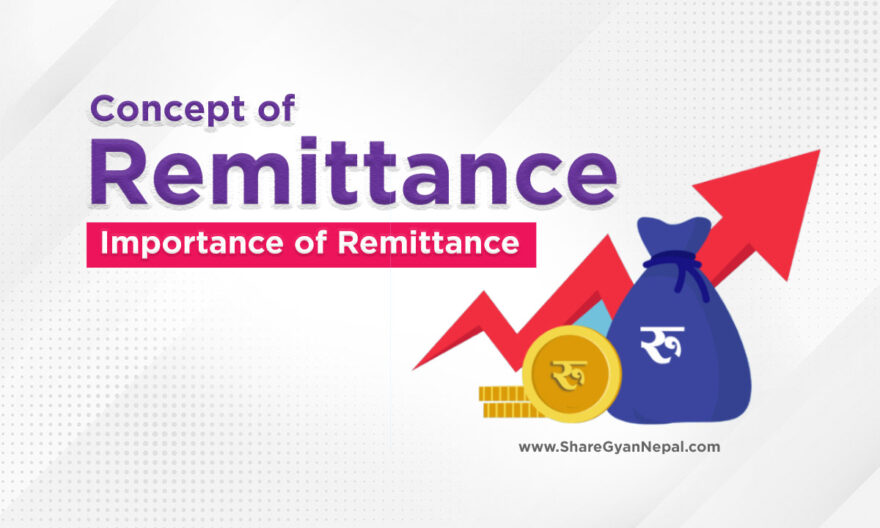
What is a remittance?
In general, remittance is the process of transferring money from one place to another play. Remittance is a very common way of transferring money from one country to another country without actually moving physical money. Remittance is a very safe non-funded business. There is at least the involvement of four parties while remitting the fund. In the context of Nepal, remittance is one of the major contributors to the national economy. Thousands of Nepali people working abroad send the money back to Nepal by means of remittance.
Types of Remittance
- Domestic remittance (within the country)
- International remittance (Transfer of money from one country to another country)
- Inward Remittance
- Outward Remittance
- Legal Remittance | Formal Remittance (by using BFIs)
- Illegal Remittance | Informal Remittance (by using of Hundi, Individual person)
Internal Remittance
Transfer of money from one place to another within a country. For example from one bank to another bank, from one person to another person within the country.
International Remittance
Transfer of money from one country to another country. It can be inward and outward. The flow of capital from immigrants to families back home is a crucial source of income for many countries.
Four Parties Involved in Remittance
There is the involvement of at least four parties while remitting the fund. They are –
- Sender/Remitter
- Receiver/Beneficiary/Recipient
- Sending Agent
- Receiving Agent

Benefits of Remittance | Importance
Remittance is playing a major role in the individual lifestyle in Nepal. Developing countries like Nepal heavily rely on remittance for the national economy. The benefits of remittance can be pointed out as follow.
1. Direct Impact on Individual Householders
Remittance is being the major source of income in many Nepalese households as money is coming from another country.
Remittance can be taken as one of the poverty-reducing factors as suggested by the World Bank. Nepali migrant workers send home billions of dollars every year. That money can be used for the household’s resources, smooth consumption, provide working capital. Most rural households rely on at least one member’s earnings from employment away from home in Nepal.
2. Long Term Growth Potential
The long-term growth of any country depends on how properly the resources are being used. For a country like Nepal, which is highly dependent on remittance, if the money is used in the proper sector then it helps in the long-term growth. Studies show that the large investment in the human capital development such as education, skill development, health care, and nutrition will eventually help in the long term growth of the country.
3. Remittance Helps of Financial Activity
Remittance also indirectly helps in the economic circulation in the country. The money sent from overseas will be circulated within the country. So, remittance promotes financial deepening.
4. Helps in Reducing the Social Unrest And Crimes
Remittance will indirectly help in reducing social unrest and crimes.
5. Contribute to Country’s GDP
Remittance helps in the economic upliftment of the country. You can check how remittance has a huge impact on the economic growth of the country.
Besides these overall benefits, the following are the benefits for Banks and Financial Institutions.
- Income from fees & commissions
- Increase bank deposit
- Increase in a financial transaction
- Customer retention
- Increase baking business
Risks Related to Remittance | Cons
- If the remittance keeps dominating the GDP, the recipient country may face the risk of real exchange rate appreciation. Which results in its economy being less competitive internationally.
- Brain drain is another risk. Due to the export of skilled manpower, the country faces a shortage of skilled manpower. That ultimately affects the entire development of the country.
- Remittance creates dependency.
- Migrant workers can not stay with their families together.
Payment Instruments | Modes of Payments
- Cash
- ATM
- Debit Card
- Credit Card
- Cheque
- Promissory Note
- Bill of Exchange
- Clearing House
- Wire Transfer
- SWIFT – Society for Worldwide Interbank Financial Transactions
- RTGS – Real Time Gross Settlement System
- LC – Letter of Credit
- Draft
- Bank Guarantee
Other Posts
- What is KYC (Know Your Customer) in Banking?
- RBB 4th & 5th Old Question Paper Collection
- What is Deposit and its Types
- Lending & Lending Principles
- Loan Classification and Loan Loss Provision

